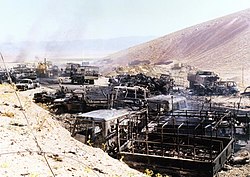| Revision as of 19:31, 7 July 2011 editDms77 (talk | contribs)244 editsm mko flag added← Previous edit | Revision as of 00:08, 8 July 2011 edit undoΔ (talk | contribs)Autopatrolled, Extended confirmed users, Pending changes reviewers35,263 edits All non-free files used on this page must have a valid and specific rationale for use on this page; please see Misplaced Pages:Non-free use rationale guideline for more information; one or more files removed due to missing rationale FAQNext edit → | ||
| Line 16: | Line 16: | ||
| * Defeat of the ] and destruction of their army | * Defeat of the ] and destruction of their army | ||
| * ] | * ] | ||
| |combatant1= |
|combatant1= ] (NLA)<br>{{flagcountry|Iraq|1963}} | ||
| |combatant2={{flagcountry|Iran}}<br>] ] (only in the northern sector) | |combatant2={{flagcountry|Iran}}<br>] ] (only in the northern sector) | ||
| |combatant3= | |combatant3= | ||
| |commander1= |
|commander1= ] | ||
| |commander2={{flagicon|Iran}} ] | |commander2={{flagicon|Iran}} ] | ||
| |commander3= | |commander3= | ||
Revision as of 00:08, 8 July 2011
| Operation Mersad | |||||||||
|---|---|---|---|---|---|---|---|---|---|
| Part of Iran-Iraq War | |||||||||
 Mojahedin army was destroyed in 1988 | |||||||||
| |||||||||
| Belligerents | |||||||||
|
People's Mujahedin of Iran (NLA) |
| ||||||||
| Commanders and leaders | |||||||||
| Massoud Rajavi |
| ||||||||
| Strength | |||||||||
| 10,000 | 10,000 | ||||||||
| Casualties and losses | |||||||||
|
4,500 KIA (Iranian claim) 1,400-30,000 executed | 400 KIA (Iranian claim) | ||||||||

Operation Mersad was the name given by the Iranian government to its successful counterattack against a July 1988 military incursion from Iraq by a military force of about 7000 members of the People's Mujahedin of Iran, armed and equipped and given air support by Saddam's Iraq. The operation started on July 26 and lasted only a few days, and was the last military operation of any significance of the Iran-Iraq War.
Prelude
After 8 years of bloody warfare, the Iran Iraq War was coming to an end under the UN Security Council Resolution 598, which was passed 20 July 1987. It is thought Iraq supported the attack to pressure Iran into a more favorable settlement. The Mujahedin under their leader Massoud Rajavi harbored the unrealistic hope that the attack would lead to a general uprising against the Islamic government of Ayatollah Khomeini. Rajavi would lead the Mujahedin with Iraqi support in an attack on the western borders of Iran.
Events
Under the codename Foroughe Javidan (Eternal Shining), the Mujahedin started their ten day operation after the Iranian government accepted UN Resolution 598. While Iraqi forces attacked Khuzestan, the Mujahedin attacked western Iran and battled the Pasdaran for Kermanshah. Close air support from the Iraqis contributed heavily to the small gains the Mojahedin made into Iran, including the seizing and razing to the ground the small Iranian city of Islamabad-e Gharb.
However, under heavy international pressure for ending the war, Saddam Hussein withdrew his fighter aircraft. Without any air cover, the Mojahedin could not stop Iranian airborne forces from being dropped behind Mojahedin lines. The operation ended in a Bay of Pigs invasion-like disaster for Mojahedin. Casualties ranged from 2,000 to 10,000. Tehran claims to have killed 4,500 NLA and Iraqi troops during the operation, while insisting that 400 Iranian soldiers were killed.
Aftermath
Main article: 1988 executions of Iranian political prisonersAt least in part as a response to Operation Mersad, Iran systematically executed thousands of political prisoners across the country, mainly members of the Mujahedin e-Kalq but also members of the Tudeh Party (Communist Party) and other opposition groups.
The estimates for number of executions vary from around 1,400 to 30,000.
References
- ^ Hiro, Dilip, The Longest War, (1999), p.246-7
- Iranian party demands end to repression
- Massacre 1988 (Pdf)
- Memories of a slaughter in Iran
- Khomeini fatwa 'led to killing of 30,000 in Iran'
External links
Categories: